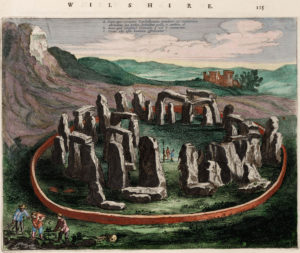Stonehenge. The name, for many, conjures a feeling of mystery or even of ancient, mystic power.
Was Stonehenge’s purpose Religious?
But is it possible Stonehenge was simply a site for an astronomical observatory? Some also believe that Stonehenge’s purpose was always religious in nature, serving as a site for worship by the Druids and other ancient pagans.
Unfortunately, the answers may not be coming soon, despite recent activity at the famous landmark.
 On April 10, 2008, news services reported that a BBC funded team in England, doing the first digging inside the massive stone circle since 1964, had broken through to a layer that had been untouched so far. These scientists have decided to tackle the mystery of Stonehenge in bits, and are currently trying to determine how and when the smaller stones, called bluestones, were transported to the site.
On April 10, 2008, news services reported that a BBC funded team in England, doing the first digging inside the massive stone circle since 1964, had broken through to a layer that had been untouched so far. These scientists have decided to tackle the mystery of Stonehenge in bits, and are currently trying to determine how and when the smaller stones, called bluestones, were transported to the site.
This team recently found in South Wales the site where they believe the bluestones originated. They are continuing their investigation in the hopes that as they can put a timeframe on the activity involving the bluestones, they can then make educated guesses about the purpose of said stones.
The Stone Arrangement
Unfortunately, that’s all they are: guesses. Experts agree that these stones must have something to do with religious practice due to their arrangement. Experts could just as easily agree that they involved impressive ancient ingenuity to get the incredibly big stones into their current arrangement.
These ‘agreements’ simply scratch on the surface of what the true purpose of Stonehenge could be. They are logical and don’t really need any research. What we’ve come to, after years of study and even these recent ‘breakthroughs’ is that we really don’t know what the original purpose of Stonehenge was.
A ritualistic practice may occur
Now we are left with speculation unless this team uncovers residue of some ritualistic practice. Or maybe they’ll find traces of sheep’s wool and come to the conclusion that Stonehenge is a massive, tough sheep pen. It’s even possible that they’ll decide that the stones were columns around which were wrapped huge linen cloths in order to form a pleasant summer home for the local king to pass hot days.
The point here, unfortunately, is that perhaps Stonehenge studies are wasted. Maybe we are better off leaving this mystery unsolved and using our academic resources in more productive areas, such as finding ways to stop students from download free essays.
But in the meantime, this BBC funded team of scientists will continue to delve deeper into the British loam, seeking the answers to one of the greatest modern mysteries. Stay tuned!






